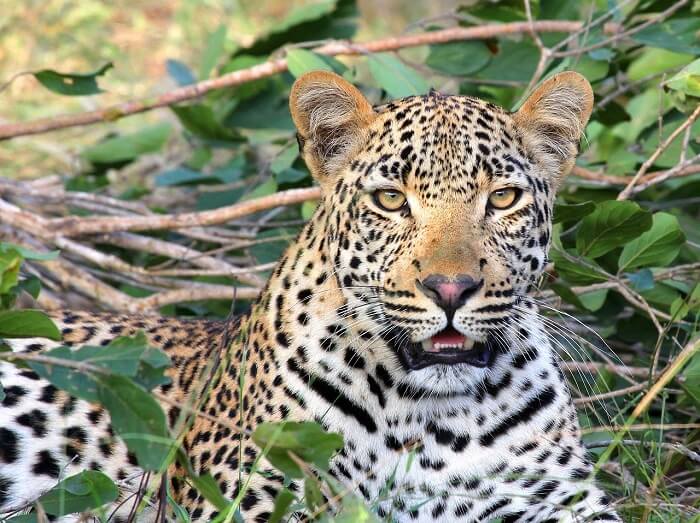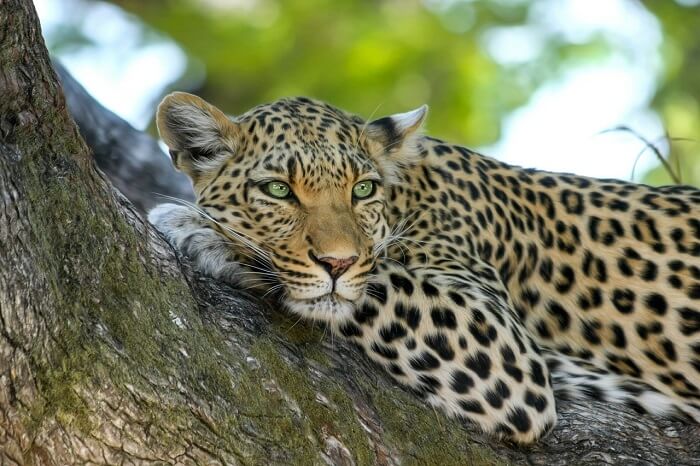Leoparın ingilizce tanıtımı. Leopar, Leopard nasıl bir hayvandır, yaşam koşulları, özellikleri ile ilgili ingilizce bilgi, yazı.

Kaynak: pixabay.com
LEOPARD
This is one cat that doesn’t need any help getting down from a tree. The leopard is so comfortable up there that it often stalks prey and even hauls its kills up into the branches.
Leopards are powerful big cats closely related to lions, tigers, and jaguars. They live in sub-Saharan Africa, northeast Africa, Central Asia, India, and China. However, many of their populations are endangered, especially outside of Africa.
You can identify most leopards by their light color and distinctive dark spots. Those spots are called rosettes, because they resemble the shape of a rose. These patterns camouflage their bodies as they move through the grass and trees. Black leopards, which appear to be almost solid in color because their spots are hard to distinguish, are commonly called black panthers.
Unlike lions, leopards are solitary creatures. Males are almost entirely solitary and females only break their solitude when they are raising cubs. But, like lions, leopards roar. Male leopards defend their territory by roaring and scent marking, while females use their roar to attract mates and call their cubs. A leopard roar is a rough rasp, like a handsaw cutting wood.
Leopard cubs are born with barely visible spots. The mother hides her cubs and moves them from one safe location to the next until they are old enough to begin playing and learning to hunt. When the cubs are about two years old, they live on their own. But the maternal bonds are strong, and offspring sometimes have reunions with their mothers.

Kaynak: pixabay.com
Interesting Leopard Facts:
- Leopard can reach 36 to 74.4 feet in length (not including 25 to 39 inches of tail) and 46 to 165 pounds of weight.
- Males are much larger than females.
- Leopard has light yellow or golden coat covered with rose-shaped black markings called rosettes. Face, limbs and belly are covered with solid black spots. Some leopards have black fur with nearly invisible rosettes (they should not be confused with black panthers).
- Leopard has large skull, sleek, powerful body, short legs and long tail which provides balance in the trees and rapid changes of direction when it hunts.
- Leopard is an excellent swimmer, agile jumper (it can jump 20 feet horizontally and 10 feet vertically) and fast runner (maximum speed: 36 miles per hour).
- Leopard has excellent eyesight and sense of hearing which facilitate detection of prey during the night.
- Leopard’s diet is based on various small and large animals such as gazelles, antelopes, monkeys, snakes, warthogs and porcupines.
- Leopard doesn’t drink much water. It obtains most of the moisture from the prey.
- Leopard is an ambush predator that targets the neck of its prey.
- Leopard spends most of the time in the trees. It stores its food and eats in the trees to protect its prey from lions and hyenas.
- Leopard is solitary and territorial animal that marks its territory with urine and claw marks on the trees.
- Leopard can growl, purr and produce rasping cough-like and barking sounds.
- Leopard can mate all year round. Female often mates with several males to protect her cubs (all males believe that they are the fathers of the offspring and thus do not have urge to kill them).
- Pregnancy lasts 3 months and ends with 2 to 3 cubs. Babies are blind and helpless at birth. They spend first 8 weeks of their life hidden in the nest and depend on the mother’s milk until the age of 3 months.
- Young leopards learn to hunt from their mother and become ready for the independent life at the age of 2 years.
- They reach sexual maturity at the age of 2 to 3 years.
- Leopard can survive 12 to 15 years in the wild and up to 23 years in the captivity.